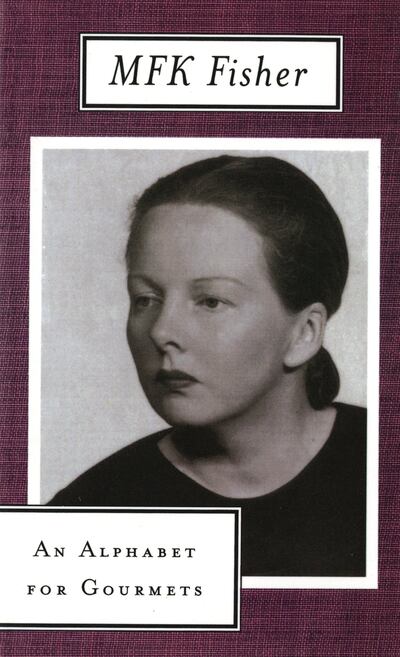Ella Rusbridger begins her introduction to this lovely edition of An Alphabet for Gourmets by recalling how and where she discovered MFK Fisher. She was 23, and it was 23 years after Fisher’s death. I was also 23 when, in 1990, I bought a copy of The Art of Eating, a compendium, for want of a better word, of five of Fisher’s best-known books, including the one I am reviewing now. Fisher was still alive then. So were Elizabeth David, Jane Grigson and Richard Olney, cooks who were also gifted writers. But Fisher was different.
Mary Frances Kennedy Fisher began her writing career as a teenage “stringer” – a freelance writer paid by the piece – on her father’s California newspaper, producing up to a dozen articles a day. An early marriage took her to Dijon, where she perfected her French and learned to cook. A second, happier marriage to the painter Dillwyn Parrish took her to Switzerland. The rest of her life was spent in Napa Valley. She wrote 27 books, including a translation of Brillat Savarin’s The Physiology of Taste, hundreds of articles for the New Yorker, and – during a brief stint as a Hollywood screenwriter – jokes for Bob Hope and Dorothy Lamour.

An Alphabet for Gourmets was first published in 1949. At the time of writing, Fisher had recently lost her mother, her brother – by suicide, and Parrish – also by suicide. She was in a miserable third marriage that had left her in debt, and caring for her ailing father and two young daughters. Fisher wrote that Parrish’s death left her a “ghost”; “A ghost, maybe, but a hungry ghost: a ghost who has no choice but to write, not just for art’s sake, but to survive,” remarks Risbridger.
Each entry is a thrillingly meandering riff, beginning with: “A is for dining Alone… and so am I, if a choice must be made between most people and myself.” She muses on solo dinners of an egg or canned soup, the perils of being a lone woman in a restaurant, and finishes with three recipes, the last of which is her austere grandmother’s salad of orange jelly on wilted lettuce, included because it is “purely horrible”. “J is for Juvenile dining” is a lovely essay about her five-year-old daughter’s developing palate, my favourite line of which is “she enjoys an occasional aperitif of Dubonnet or white wine with soda water (proportions about one to 50.)”
READ MORE
It should be stressed that few of the recipes would inspire a modern cook to grab an apron. Calf’s head à la torture comes with advice to procure two extra ears “as four make the dish much handsomer”. Garum (400 BC), simply calls for fish insides, salt and plenty of fresh air. A fond memory of carrying her Aunt Gwen’s fried egg sandwiches in her pocket lost its charm for me when I realised that the bread was fried too… I can’t even, as my daughter would say. But coming as they do at the end of each entry, their inclusion needs no justification; the joy of reading this book is in following Fisher’s train of thought.
As for the prose. WH Auden considered Fisher one of the great American writers. It took me several weeks to reread this book. Every few pages I had to stop and go back over sentences, many of which are paragraph-length, sometimes reading them aloud. Not because they lack clarity, but to figure out how the hell she does it. There are Anne Enright levels of syntactical gymnastics here.
Finally, a word for Ella Risbridger’s introduction: she was an inspired choice. Her 2019 book, Midnight Chicken & Other Recipes Worth Living For, is at once cookbook, memoir and elegy for the late partner who taught her to cook. She sees through Fisher’s irony and humour to the grief she carried as she wrote An Alphabet for Gourmets. And understands that it is an alchemy of time, place and the company of loved ones that makes a meal memorable.
If this tempts you to buy her book, I recommend the paperback; it comes with extra writing and, like most of the best cookbooks, no photographs.
Louise Kennedy is a former chef and author of Trespasses, winner of Irish Novel of the Year













